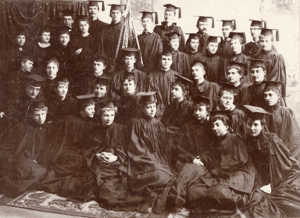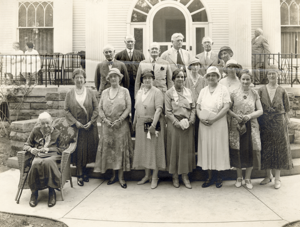Fannie Rosalind Hicks Givens facts for kids
Quick facts for kids
Fannie Rosalind Hicks Givens
|
|
|---|---|
| Born | May 29, 1861 Sturgeon, Missouri, US
|
| Died | August 4, 1947 Louisville, Kentucky, US
|
| Occupation | Artist, political activist, policewoman |
Fannie Rosalind (Hicks) Givens (May 29, 1861 – August 4, 1947) was a talented artist, a dedicated missionary, and a strong political activist. She lived mostly in Louisville, Kentucky. Fannie created and taught many types of art, like painting and poetry. She also worked as a policewoman for the city. She was very active in politics, traveling worldwide to fight for the rights of Black people and women.
Contents
Fannie's Early Life
Fannie R. Hicks was born around May 29, 1861, in Sturgeon, Missouri. When she was a young child, her family moved to Louisville, Kentucky. It is thought that her parents were enslaved before they moved north.
On June 27, 1895, Fannie married James Edward Givens. He was a Harvard graduate and a professor at State University, which is now Simmons College of Kentucky. Fannie took her husband's name and became known as Fannie R. Givens. They did not have their own children. However, they adopted James' niece and also cared for her four brothers and sisters.
Fannie's Education
Fannie Givens went to high school in St. Louis and Chicago. In 1892, she graduated from Knox College. Many believe she was the first Black woman to graduate from their art school. At that time, she lived in Colorado Springs, Colorado.
She also studied at State University and Louisville Municipal College. Fannie even took a special "correspondence course" from the Henry George School of Social Science in New York City.
Career and Artistic Work
After graduating from Knox College, Fannie Givens returned to Louisville. She became the head of the art department at Simmons University. This school was known as State University back then. Her department had 23 students. Their artwork was shown in Chicago at the World's Columbian Exposition in 1893.
Famous Portraits and Art
Givens was well known for her portraits. She presented a portrait of John L. Waller to President Benjamin Harrison. This painting was hung in the White House. She also painted a portrait of Booker T. Washington.
Because she was interested in African art, Prince Massaquoi honored Givens as a Princess. This likely happened when she visited Liberia. A life-sized portrait she painted of a woman named Mrs. Talbert was displayed in the Frederick Douglass Home.
Teaching Art and Writing
Fannie Givens taught art from her home in Louisville. She was the only Black person listed as an "artist and portrait artist" in the Louisville City Directory. She also wrote poems and songs. Her poem "Glimpses of the Old World" was kept in the Congressional Library. She wrote many more poems and copyrighted the song ""Hallelujah! Christ is Risen."
Traveling and Activism
Givens traveled a lot in Europe and Africa. She did this for different groups she was part of. These included the Baptist World Alliance and the National Association of Colored Women (NACW).
While on a ship called the Adriatic, Givens faced unfair treatment. She reported that Black passengers were given bad seats and separate food lines. Fannie, along with another Black passenger, stood up for themselves. Givens then went on a hunger strike for three days. She refused to eat because she was being treated differently. She met with the captain and told him she paid the same as white passengers. She said she should not be treated differently because of her skin color. After this, she reported that she had no more problems.
Community Leadership
Givens was involved in groups that brought Black Americans together. She also worked to make art more available to everyone. She was president and manager of the National Historical Art League. She led the Art Department at State University. She was also the head of the Kentucky Association of Colored Women.
In 1918, Givens, Mary Virginia Cook Parrish, and William Spradling started an art school. It was part of the National Historical Art League. Givens tried to raise $100,000 to build an art institute for Black artists at Howard University. Sadly, not enough money was raised.
Political Roles
Fannie Givens was very active in her community's politics. She served as a delegate for the Republican Party (GOP) from the 4th Ward starting in 1921. In 1927, she spoke out about getting money to build the Ohio River Bridge.
That same year, Givens became Louisville's second Black policewoman. In 1938, Givens and three other women were let go from their jobs. The Safety Director, Sam H. McMeekin, said they "had no specific duties." The Police Chief, John M. Malley, did not change this decision.
By 1935, she was the president of The World Union of Colored Women for Peace and International Concord. On September 30, 1936, the Eta Zeta chapter of Zeta Phi Beta sorority honored Givens. She was a former leader (Grand Basileus) for the sorority. She is listed as a notable Zeta Phi Beta sister.
Later Life and Passing
In 1932, Givens attended her fifty-year reunion at Knox College. In Louisville, she was a member of the 5th Street Baptist Church.
Fannie Givens passed away on August 4, 1947. She died at her home in Jefferson County from breast cancer. She was buried with her husband in Eastern Cemetery. A special plaque from Zeta Phi Beta decorates her grave.
|



